

Specifications and Cost
History, construction and performance
Specifications
LOA 13’ 8”
Beam 4’ 3”
Draft 6” to 2’ 6”
Displacement 235 lbs.
Sail area 62 sq. ft.
Cockpit length 6’ 1”
Spars (3) length 10' 0", and all equipment, will stow inside the boat
13’ 8” x 4’ 3” x 235 LBS.
Melonseed Skiff Cost
As of January 15, 2022 the base price is $15,900
Includes: Solid fiberglass hull, mechanically and chemically bonded to a fiberglass deck (cored construction). All work done by hand lay up. Teak cockpit combings, rubrails, floorboards, rudder and tiller. Hand rubbed oil finish is standard on all teak. Solid Douglas fir spars (mast, sprit and sprit boom) are beautifully varnished. Dacron 62’ spritsail in choice of Tanbark (rust red). Linen (off white) or White. Dacron rigging. Bronze hardware: bow eye, oarlocks, eye straps on aft deck, mast hardware, rudder head and sheet block, pintles and gudgeons. 4” bronze deck cleat on bow available at n/c if desired. Centerboard model w/PVC board is standard. One pair of seat/rowing/flotation cushions included. Leathers on sprit and boom n/c.
Standard Hull Colors

Black

Dark Green

Dark Blue

White

Ivory
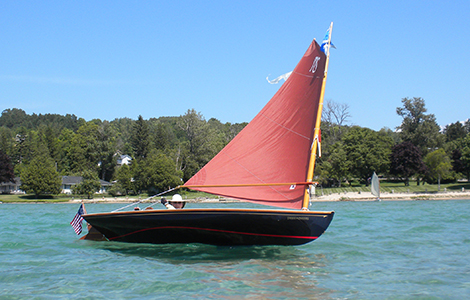
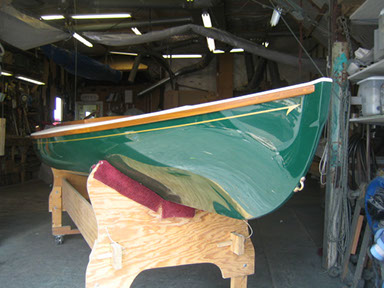
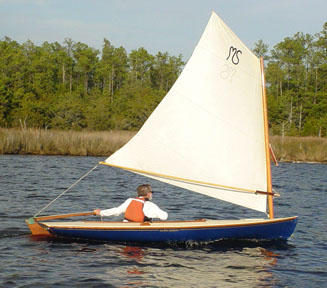
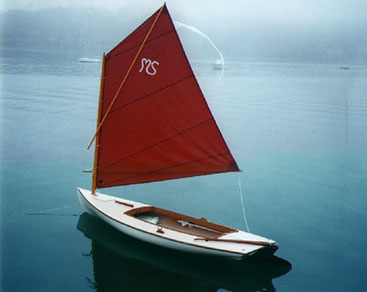
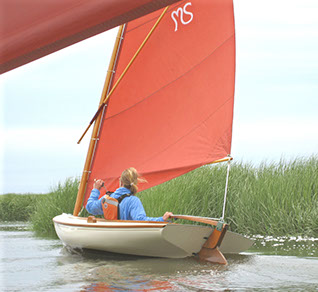
Standard Sail Colors
Standard Deck Colors





Tanbark
Linen
White
Beige
Ivory
Payment Schedule
Payment Schedule: Approx 50% deposit with the order.
Balance due at the time of completion.
Prices and specifications subject to change without notice, and are
F.O.B. Marshfield, MA 02050.
Nationwide shipping with full insurance is available on request.
Optional Items
$700 Mooring cover (waterproof, and covers the complete deck)
Beyond the cost of the boat itself, one of the best investments you can make is the mooring cover. It covers the entire deck of the boat completely from the bow back to the stern and comes down over the sides of the boat about 4”.
It is made from a very durable and completely waterproof material called “Top Gun”. There are three ¼” lines connected to the lower edge of the cover’s skirt on one side of the boat, and they go under the boat to tie to grommets on the opposite side. These cover lines really synch it up almost drum head tight. There is also a drawstring cord around the lower edge of the cover’s skirt that can be pulled in to further tighten the cover.

woodwork is nothing short of beautiful. This mooring cover not only keeps the boat dry and clean, but it protects the teak and all this fine workmanship (and if you choose it, the embellishment of the Sikkens Cetol finish on the teak), and all rest of your gear which of course live conveniently inside the boat. With the addition of a mooring cover, your maintenance is reduced to a bare minimum. The sail rig, spars, rudder, tiller and all your sailing gear live happily in a dry safe environment whether the boat is stored on the trailer, dock, beach or mooring.
The mooring cover is so secure on the boat that it is quite happy going down the highway at high speeds, and if you are traveling with overnight stops it is worth noting that whatever is stored in the boat falls into the category of “what people don’t see, they don’t covet”.
$150 7 1/2' standard lightweight straight blade oars
The Melonseed was originally used as a hunting boat that needed to be capable and handy in all weather conditions, including times when there was little or no wind. The inclusion of oarlocks and oars was a practical matter. She is a very, very good rowing boat, one that will surely please you if you just choose to take her for a good spin under oars. There are often times when rowing might be a comfort or necessary when you have to maneuver in close quarters around a dock, or in the fading wind of a summer evening when you just need to get back home on time.
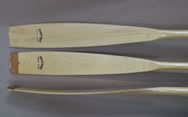
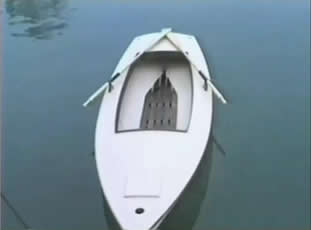

When asked how well the Melonseed goes to upwind in very light air, the response is “Pretty good, and if necessary she goes dead to windward at three knots!” Under oars that is.
The “standard straight blade oars” are just that. They offer reasonable quality and performance for a fair price and will get you where you have to go. They are stored up under the side decks with shock cords that come standard on the boat. Beautiful bronze oarlocks are also standard equipment. The boat needs an oar of exactly 7½’ in length. If you have some of your own, that’s great, or we are happy to provide them.
There are upgrade options with oars that you might consider, although we do not provide them. Here’s the thinking on this. If you are not an experienced rower or have little reason to think you will row other than on rare occasions when necessary, then I would not consider spending a penny more than you have to on oars. If you are a rower of average skill, then the standard oars will do quite well. If you are a long time rower of considerable skill then, yes, the standard oars will still do nicely but you might long for something spiffier. This is where the Shaw & Tenney spoon blade oars come in.
Shaw & Tenney spoons as they are set up with leathers and buttons and are each works of art. They are very expensive and should be handled with care. When used by a skilled oarsman, the difference between the standard straight blade oars and the spoon blade oars is like regular gas compared to jet fuel!
They are well worth the money if you row very well or want to learn to row at that level, but frankly a very unnecessary expense if you are just going to be dubbing around with your oars upon occasion.
You can investigate these oars at http://www.shawandtenney.com/wooden-rowing-oars.htm
If you call Shaw & Tenney to order, then you will probably speak with Steve, and when you do just simply tell him that you are having a Melonseed built for you and you need oars. He’s a most pleasant and accommodating fellow and will know just what to do for you. You can have the oars sent to us to be awaiting you with your new Melonseed Skiff, or they can be sent right to your door.
$195 Boat name and pinstripe on the hull sheer done in gold mylar tape
Want to further embellish the Melonseed’s graceful sheer line and add a real touch of class to the whole appearance of the boat? Nothing does it for less money than the pinstripe and name. While the boat is certainly lovely, the addition of this option is that little extra difference that really makes a statement..
The pinstripe is interrupted amidships and the name is located there, as this is where it is most visible. The pinstripe shows exceptionally well against all the hull colors, particularly the dark colors. The tape itself is very durable, and we have seen names and pinstripes on boats over fifteen years old that look remarkably good. The mooring cover plays a big role here as it covers the name and pinstripe, protecting it from weather and UV damage.
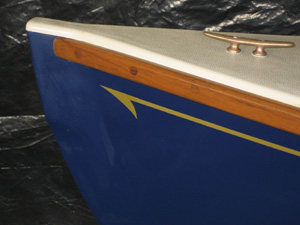
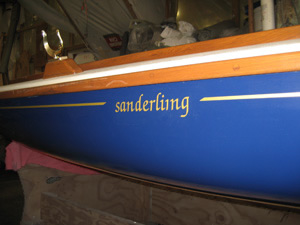
The adhesive qualities of the vinyl are excellent and yet if it was damaged from abrasion, it can be easily removed with a warm air hair dryer, and a new section applied in minutes. This is a lot less expensive than paint or gold leaf.
Maybe the overall benefit of the addition of the name and pinstripe is to think of the saying “What’s a kiss without a hug”.
$600 Sikkens CETOL finish on the teak woodwork (except floorboards)
This option takes a little explanation. First of all you can have the teak finished with hand rubbed teak oil at no charge, and this looks fine. For a while. It is the very nature of an oil finish that it dries out and fades after a short while and the teak starts to look a little lackluster. You can always put on some more on, and it will fade and the process is ongoing in this cycle. At some point however the teak starts to collect salt and dirt and gets gummy and needs a good scrubbing and cleaning and then a fresh coat of teak oil. There is nothing wrong with this scenario though IF you are faithful about the maintenance.
Teak is a remarkable wood. It is very expensive, beautiful and will last a lifetime as it is impervious to rot. In some cases you can in fact to nothing at all to teak, and let it weather to a dry silvery state, but not on the Melonseed. The slender 3/8” thickness of the wood might become unstable if left to dry out and warping or cracking might occur. So some sort of a finish is necessary.


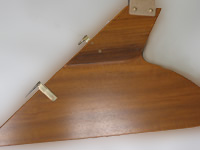
Cetol is far and away the best finish for teak that has ever come along. We have been using Cetol on the Melonseeds since 1994 and find it to be excellent in its performance and appearance.
Cosmetically, it is not a high gloss finish and has a slight “satin” look. It highlights the beautiful colors and grains of teak and gives it a rich appearance.
There are two outstanding features to note about Cetol. First, think of is as behaving like “Gore Tex” because it breathes. When water vapor gets behind the Cetol finish, it can migrate back out without causing the blistering and cracking that occurs with the hard finishes like varnish or paint. Secondly, and maybe most importantly of all
is that you can spot touch it up, and unlike varnish it just blends right in to the old finish within minutes and is a perfect match.
Typically the annual maintenance with Cetol is to just go around the boat once a year with some fine sandpaper and lightly scuff up any worn or scratched areas and then touch it up with a dab or two with Cetol. Cetol lasts so well and looks great for so long that it may be several years before you have to completely re-coat it. When that time comes, sand off the surface layer and apply a new one with a 2” foam brush, and when you do that you will find that it brushes out beautifully and easily. Note that the manufacturer, Sikkens Paint Co., suggests that you only have a total of three coats of Cetol on the wood as a denser layer of it will negate the micro porosity feature. A new Melonseed with Cetol has just that….three coats.
So here’s the bottom line; if you do a time vs. money comparison you will find that to achieve the same quality of appearance, you spend only a few minutes a year caring for your Cetol and it always looks good as opposed to a LOT more time and effort caring for your teak oil finish which at times is not always in prime condition. In either case, your mooring cover does a lot to keep the wood in good condition.
If you are economizing and trying to reduce the overall purchase cost of your new Melonseed, then Cetol would be the first options to decline. The boat sails just as well with oil or Cetol on the teak. If you want the best looking boat possible and the least maintenance then Cetol is a great choice.
$125 Ensign and teak flagstaff on rudder head
This option is really just a way to add a few more “style points” to an already classy look.
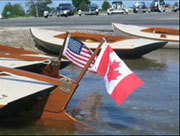
The flag measures 12” x 18”, and the end of the staff inserts into the tiller after it passes through the bronze rudder head. A United States nautical ensign is standard.
Galvanized Load Rite brand boat trailer custom matched to MS hull - Inquire about price
Load Rite is one of the best brands available in the trailer business, and we have been using them for about 20 years with satisfaction. They make a small boat trailer that is perfect for the Melonseed, it offers plenty of weight capacity (it is rated for 800 lbs.), and the trailer can be set up nicely to support the MS hull shape. The overall length of the boat with the trailer sitting on it is about 17 ½’ and will fit into most garages easily.
When each new trailer arrives at the boat shop, we disassemble and rearrange the bunks, rollers and supports so that the Melonseed’s hull is cradled and carried perfectly. We will build you a strong and beautiful boat, and it is in our best interest as well as yours that “our” boat lives a happy life when it is not in the water and on the trailer.
You are welcome to shop around and find your own trailer, and we will offer guidelines on what you need and how to best set it up yourself, although if it requires any significant time on our part to readjust it you may be charged for that service.
The Load Rite trailer comes standard with 8” wheels and they are adequate for most people. If you do a great deal of long distance highway driving, then it might be to your advantage to upgrade to 12” wheels. These larger wheels turn fewer RPM’s and will generate less wear on the bearings. The boat is a little easier to launch in very shallow water with the 8” wheels as you are lower to the water, but either height works fine.
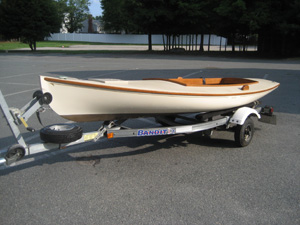
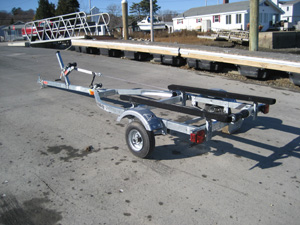
You’ll need to know the following to set your vehicle up for trailering:
The coupler connects to a 2” trailer ball
The plug on your vehicles wiring harness that connects to the trailer’s light plug is best described as a “FOUR WIRE, FLAT” plug. Your mechanic will know what you mean with that description.
The “tongue weight” of the trailer, that is the downward load that the coupler puts on the trailer ball is minimal, and it is only about 35 pounds.
The total weight your vehicle will be pulling, the combined weight of the boat (235 lbs.) and the trailer (180 lbs.) is only a modest 415 lbs.
You will not need a monster sized hitch system to pull the Melonseed.
We’re pretty good boat builders here at Crawford Boat Building, but not great car mechanics, so it is imperative that you get the wiring for the trailer lights and the hitch installed and working properly before you leave home and not when you arrive here.
In order for you to drive the boat and home with a legal license plate from your home state, you’ll be mailed a bill of sale for the trailer showing it paid in full, and a “title” or Certificate of Origin showing the ownership legally transferred to you. You provide these documents to your state agency and they will issue you a registration and license plate that you then bring here and put on our new trailer.
$60 Ritchie compass hand bearing
The Ritchie “Sportabout” marine hand bearing compass is a small simple hand held compass with a 2” direct reading dial. It is encased in a yellow rubbery case, has a neck lanyard and is pretty darned durable. There are some advantages to this compass vs. the combing mounted version (they are pretty much the same compass). You can use it to easily take multiple bearings to help locate yourself, it is a lot less vulnerable than the combing mounted compass to being damaged from accidental impact, you can set it down anywhere in the boat you want and you can take it ashore with you for use on land if you wish.

$95 Ritchie compass mounted on combing
This version of the compass is permanently mounted on the forward combing. It is set up to flip up and down, and in the down position is a little less vulnerable to being damaged from impact. This compass is the same size as the hand bearing version.
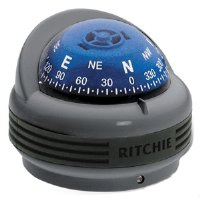
$400 Lifting Bridle and hardware for single point lifting from crane or davits
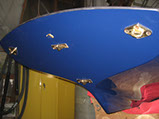
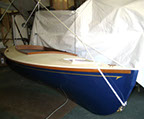
$600 Custom Melonseed half model to match boat on a teak backboard
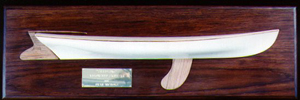
Custom Hull Color - please inquire
Black, dark blue, dark green, white or ivory are standard at no charge.
Other custom colors and prices can be discussed.
The original drawings of this boat appeared in Chapelle's "American Small Sailing Craft", and were dated prior to 1888. The MELONSEED was originally a sailing and hunting boat developed in the New Jersey Bay and Delaware River areas. The design was intended to be more of an open water boat, drier, and more seaworthy than similar boats of that era.
It is important to note that although times have changed, the sea has not! Today, computers can design boats that may be fast and streamlined, but they will never improve on the simple elegant beauty of the MELONSEED SKIFF and the other traditional small American working craft of the last two centuries.
It is not necessary to trade off speed for looks with the MELONSEED. We have sailed the boat in a wide range of conditions, ranging from summer zephyrs to small craft warnings in December. Her speed is exhilarating on all points of sail and she will go very well to windward even in a stiff blow. Off the wind you can enjoy the thrill of planing and surfing. The hull is sea-kindly and impeccably well mannered. She has proven so stable in our testing that the sail plan has been generously increased vs. the original drawings. Put quite simply, it is both SAFE and FAST! The wonderfully simple and efficient sprit rig is ideally suited to the MELONSEED, and rounds out the charming overall appearance.
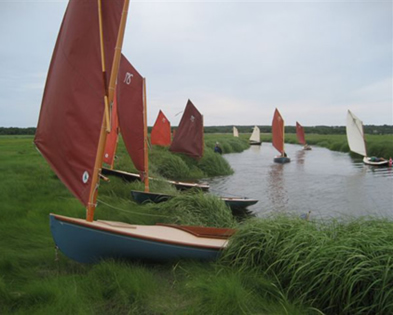
Performance under oars is equally delightful as she is surprisingly swift, tracks very well and carries an ample load easily. Transport and launching by trailer is very simple.
The MELONSEED is built to our usual high standards of quality construction, combining solid structural integrity with a thoughtfully detailed finished appearance. All fiberglass work is carefully done by hand using a combination of woven, matted, biaxial and core materials. The canvas-like texture of the deck is handsomely combined with teak combings, floorboards and woodwork. Spars gleam with multiple coats of varnish. Sail and rigging are dacron. Hardware is bronze, fastenings are stainless and bronze. A proper little yacht!
We have been thoughtful in our reproduction of the design, faithful to the boat's tradition, and have produced a wonderful blend of performance and appearance.
We can't all afford to own a big boat, but we can own a good boat!!
That's the point of all this. A well designed and built small craft can let you become intimate with the real and simple pleasures of boating.
If you have found interest in what you have read here, we urge you to contact us so that we may share more information and photographs or video with you, describing the remarkable MELONSEED SKIFF.
